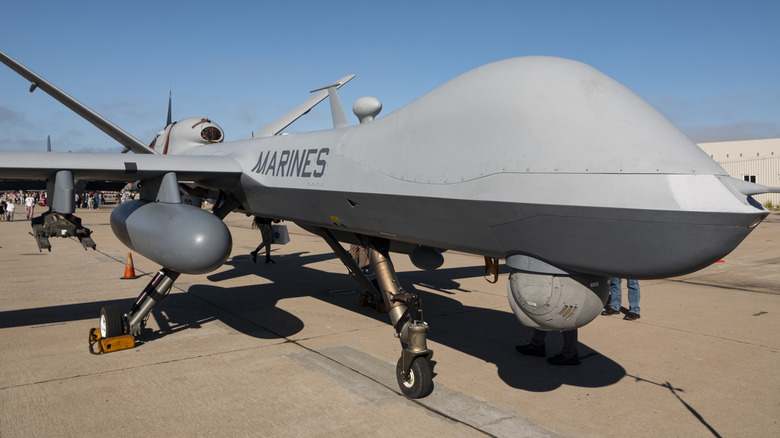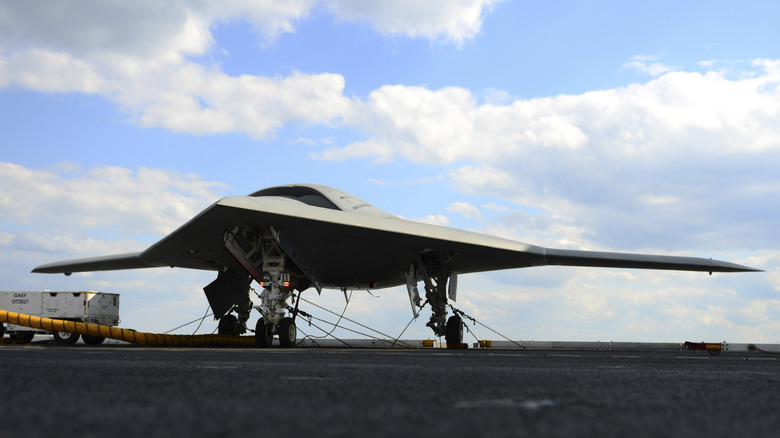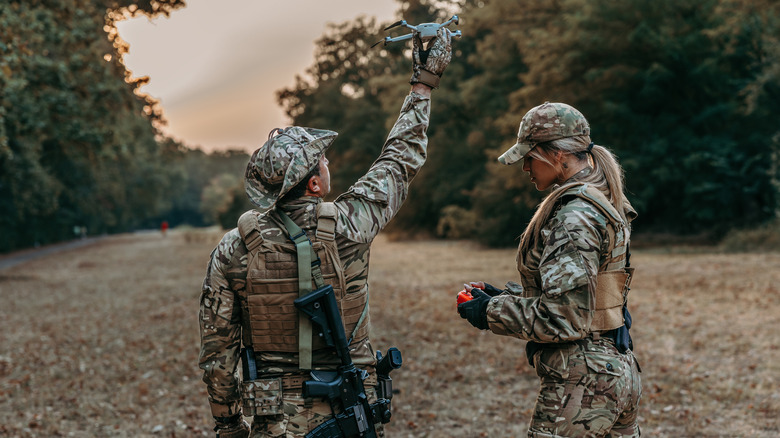How High Do Military Drones Fly? A Look At Altitude Limits
The United States armed forces have been gradually transitioning from traditional manned vehicles like jets to drones, otherwise known as unmanned aerial vehicles (UAV), reducing the amount of risk in combat missions. When a drone is shot out of the air, there's no risk to life, which is rather ideal. Engaging with enemy units isn't the only mission drones undertake, however. They're also used for reconnaissance missions, gathering information via onboard cameras on rivals and transmitting it back to base. When the military chooses a UAV to adopt, it looks at a few aspects.
No drones are built the same. Some UAVs are as large as fighter jets, designed for combat and a variety of other missions, while others can be carried in a backpack and have a single purpose. The speed a drone can fly is important when choosing a drone to add to the military's arsenal, but just as vital is its maximum ceiling. The higher an aircraft can fly, especially if it's built for surveillance, the better view it can have of its target below. Reaching certain altitudes can provide a significant advantage from not being seen by ground troops to having a clear line of sight on a target. Additionally, a higher altitude can help drones avoid detection. So let's take a look at a few of the drones and the maximum altitude they can reach.
Northrop Grumman builds some high-flying drones
Some drone data isn't explicitly stated by the manufacturers — likely to protect sensitive data or national security — but they sometimes give a rough estimate. Northrop Grumman has quite a few drones out in the field, so let's take a look at the machinery they're selling. Northrop Grumman's MQ-4C Triton, "...can fly at an altitude upwards of 50,000 feet, which is significantly higher than commercial aviation or medium-altitude, long-endurance (MALE) aircraft." It's designed for high-altitude surveillance, making such a high altitude necessary.
The defense contractor doesn't list the maximum altitude for its RQ-4 Global Hawk, but the USAF does. According to the USAF, it can fly as high as 60,000 feet, which is just shy of 12 miles. Northrop Grumman's RQ-180 drone that looks similar in design to the B-21 Raider is designed for stealth and reconnaissance, meaning it needs to be able to fly high enough to collect intelligence, and it accomplishes that. It can reach an altitude of 70,000-feet, giving it a clear view of the ground for hundreds of miles. It's not a very large plane — just a 66-foot wingspan — making it difficult to spot with the naked eye.
Lastly, there's Grumman's X-47B drone, designed to be a strike fighter for the US Navy. It can travel as high as 40,000 feet. There are no intentions to operationalize the X-47, but it is supporting the Navy in its plans for future carrier-based unmanned aircraft.
Other manufacturers build drones that can go just as high
The most recognizable UAV used by the USAF is the MQ-9 Reaper, built by General Atomics. While its primary mission is to surveil unsuspecting targets, it can also be armed with laser-guided missiles for instances when a precision strike is necessary. Its maximum ceiling is 50,000 feet. The other UAV General Atomics delivers to the military is its MQ-20 Avenger. This drone, like the Reaper, can fill a variety of roles from surveillance to strike missions. General Atomics designed it to fly medium-to-high altitude, with 50,000 feet being its ceiling. You can't forget about Lockheed Martin, which has designed and built multiple aircraft for the US military, such as the SR-71 spy plane.
Lockheed's experience with building such an iconic spy plane likely came in use when it got to work designing the RQ-170 Sentinel. The USAF is testing out the Sentinel system to capture real-time photographs that it can snap at an altitude of 50,000 feet. One of the lesser known manufacturers here is Skydio, of which builds the Skydio X2 drone. This is a short-range drone used by the US Army that's small enough for soldiers to carry by hand. Because of its small stature, it doesn't reach the same altitudes as any of the aforementioned drones, but it can reach a comparatively modest 1,500-feet.


